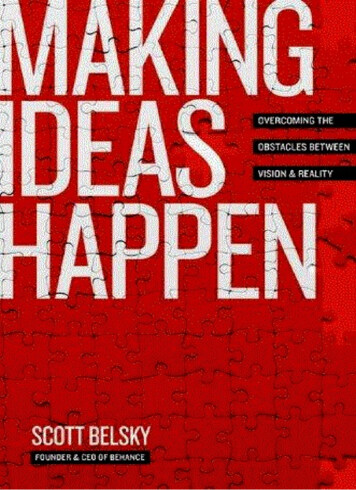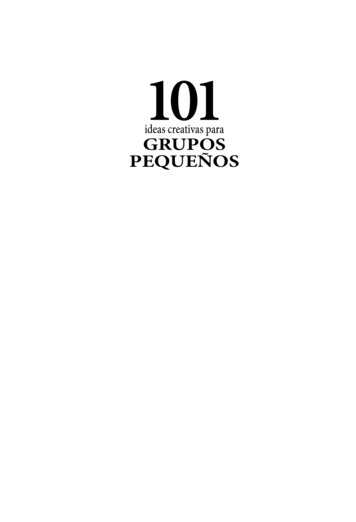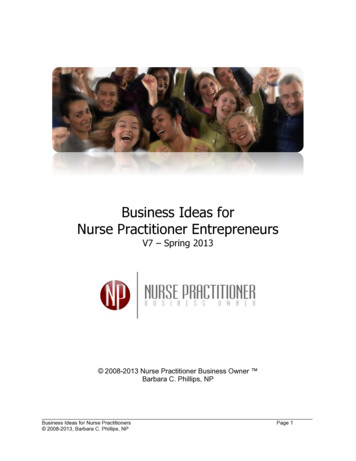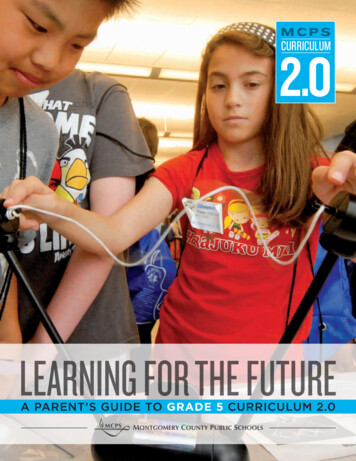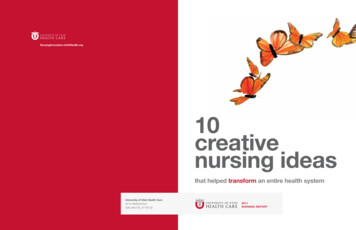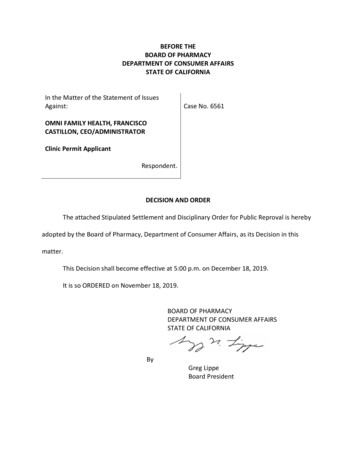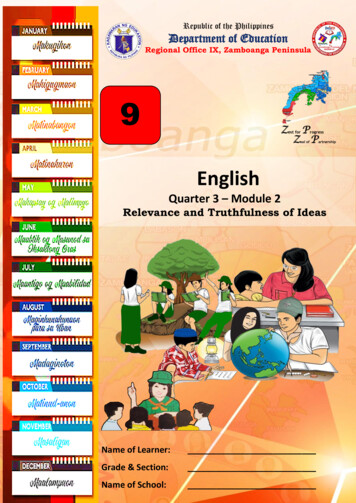
Transcription
Republic of the PhilippinesDepartment of EducationRegional Office IX, Zamboanga Peninsula9Zest for ProgressZ Peal ofartnershipEnglishQuarter 3 – Module 2Relevance and Truthfulness of IdeasName of Learner:Grade & Section:Name of School:
English – Grade 9Alternative Delivery ModeQuarter 3 – Module 2: Relevance and Truthfulness and IdeasFirst Edition, 2020Republic Act 8293, section 176 states that: No copyright shall subsist in any work ofthe Government of the Philippines. However, prior approval of the government agency oroffice wherein the work is created shall be necessary for the exploitation of such work for aprofit. Such agency or office may, among other things, impose as a condition the payment ofroyalties.Borrowed materials (i.e., songs, stories, poems, pictures, photos, brand names,trademarks, etc.) included in this module are owned by their respective copyright holders.Every effort has been exerted to locate and seek permission to use these materials from theirrespective copyright owners. The publisher and authors do not represent nor claim ownershipover them.Published by the Department of EducationSecretary: Leonor Magtolis BrionesUndersecretary: Diosdado M. San AntonioDevelopment Team of the ModuleWriter:Editors:Reviewer:Layout Artist:Management Team:Entizar A. Ibrahim, MAEdEdna A. Natividad, MAELSRosalie M. Alvarez, EdDJamwhell V. Ortiz, MATESPValeria Fides G. Corteza, PhDJovie R. Cruz, MAEdRoy C. Tuballa, EMD.JD.CESO VIJay S. Montealto, CESO VINorma T. Francisco, DMMildred D. Dayao, EdDValeria Fides G. Corteza, PhDAida Coyme, yDepartmentEducationRegion– RegionDepartment of EducationIX –IXZamboanga PeninsulaOffice Address:Pres. Corazon C. Aquino Regional GovernmentOffice Address:Center, Balintawak, Pagadian City, Zamboanga delTelefax:Sur Province 7016E-mailAddress:Telefax:(062) 215-3753, 215-3751, 991-1907, 215-3789E-mail Address:region9@deped.gov.ph
What I Need to KnowIt is with information technology that distance is being defied. With just a click of abutton, you have emails, voice mail, Facebook, vlogs, instant messaging, and many morevirtual platforms that allow you to connect to the world. In many ways, your life has beenmade easier and more efficient with technology that enables you to communicate thefastest way possible. However, it is essential to know how to see the truth and relevancebehind information read and listened to, especially with the growing number of fakeaccounts and news in the digital era.This module is done to discover the extent to which you can connect to other peoplewith different personalities and needs using technological advancement and be able toenhance your reading skills in terms of judging worthy of ideas presented in texts.In this module, you are expected to:a. judge, the relevance and truthfulness of the ideas, listened to;b. analyze the worth of ideas presented in the text listened to;c. analyze a radio play and ICT texts as a means of connecting to the world;e. provide critical feedback/reaction to a specific situation; andd. use an infographic to disseminate information.What I KnowA. Directions: Choose the letter of the best answer. Write your answer on a separate sheet ofpaper.1. Which of the following statements is TRUE about technology?A. It makes life convenient and easy.B. It allows people to discover and travel to new places.C. Information can be taken with just a click of a button.D. All of the above2. What is information technology?A. It contains information needed in our research work.B. It involves all software and hardware used in the creation, storing, and accessing ofinformation and involving communicationC. It is a tool to help people gain strength in physical endurance.D. It encompasses the use of free data to access information on the internet.3. Why do you need to filter information taken from the internet?A. They may allow us to locate people who live in different places.B. They may contain information that is not factual and relevant.C. They may contribute to our economy's progressD. All of these4. Which of the following is an example of information technology?A. TelephoneB. mouseC. CPUD. calculator1
5. Which of the following applications is best used for video conferencing?A. TiktokB. Google MeetC. Pic CollageD. TwitterB. Directions: Put a check on the blank that applies to you. Write your answer on a separatesheet of paper.1. I use it when I communicate with my family and peers.2. I use it when I sell products to help me earn extra income.3. I use it when I research information and data needed for my class.4. I use it when I play video games and surf Facebook.5. I use it when I need to respond to an emergency.Lesson1RELEVANCE ANDTRUTHFULNESS OF IDEASThe judgment of ideas, points of view, and arguments presented in texts or otherplatforms are important for students' growth as independent thinkers. Learning how to analyzeand critically evaluate information's truthfulness helps you develop a sound framework to testyour arguments and enrich your points of view.Moreover, it is only through sound judgment and worth of ideas that students candistinguish among challenging claims for truth and determine which arguments and points ofviews they can trust and those of which they should be skeptical, especially when they viewand/or listen to the information in the internet or other technological advancement.What's InDirections: Read the summary of a radio play presented below and answer the activity thatfollows.Sorry, Wrong Numberby Lucille FletcherMrs. Elbert Smythe Stevenson is the only character in Lucille Fletcher's1943 drama, which was originally produced for the Suspense radio program. Aninvalid whose unspecified health condition keeps her confined to her bed in anupstairs room, Mrs. Stevenson (whose first name is not provided) is usuallyattended by a maid. On the night the drama takes place, she has given the maid thenight off. As her husband, Elbert, is still at work, she is alone.2
The play opens with Mrs. Stevenson speaking to the telephone operator.She reports that her attempt to call a particular number was unsuccessful.Surmising that some wires had gotten crossed, she reports that she was patchedinto the wrong number. The conversation between two men that she listened torevealed "the most dreadful thing," a murder plot. She directs the operator to tracethe call. (The audience cannot hear the operator's lines of dialogue.)Mrs. Stevenson admits to the operator that it was not her business, but shedefends her actions because the men she heard are "cold-blooded fiends" who aregoing to commit murder. The intended victim is a "poor, innocent woman," alonein her house, which is near a bridge. She pleads with the operator to help her stopthe would-be killers. Mrs. Stevenson speaks sharply to the apparentlyunsympathetic operator, blaming them for misdialing her original call. Shesuggests that the operator repeat their original, careless mistake.The operator apparently does not comply, as Mrs. Stevenson gets the busysignal of the number she had originally dialed. Mrs. Stevenson redials the operatoragain and becomes more insistent, saying that tracing the call is her "civic duty."She now agrees to be connected to the chief operator, to whom she repeats herstory. Mrs. Stevenson insists that it is absolutely necessary to stop the terrible, coldblooded murder of an innocent woman.She provides her own name and phone number to the chief operator,repeating her demand that the other call be traced. She again provides the reasonthat her intent is to prevent the dangerous men from killing someone, which willoccur at 11:15 that night. As the operator apparently tells her to contact the policedirectly, she first dismisses the "idiotic" suggestion as tying her up in "red tape,"then hangs up and calls the police.Stating that she is reporting a murder, she revises the claim to indicate thatit is a forthcoming murder. The men she heard are planning to murder a womanwho lives "in a house near a bridge." Other details of their conversation includereferences to the client who hired the men to kill her with a knife and steal herjewelry. As she provides her name, phone number, and address, she reveals thather home is near the Queensborough Bridge and Second Avenue. She also statesthat she is invalid, her husband is working late, and it is the maid's night off. Sheasks that they send a radio car.As she muses that the neighborhood described sounds like her own, she alsoadmits that she is nervous about being alone. She describes her maid, Eloise, asbig and strong but lazy and tells them how much her husband adores her. She hasbeen ill for twelve years. As the police officer apparently declines to help, sheinsists that her situation is a high priority, calls him an idiot, and slams down thephone.Next, she calls the operator again and has them call her husband's number,3
which is still busy. Then the phone rings. When she answers, there is no one there.This happens once more; then she redials the operator. Admittedly very nervous,she berates the young female operator for the inefficient service and her"unpardonable rudeness." Stressing her own "suffering," she explodes: "You're sostupid!"After she hangs up, the phone rings again, and again no one is there. Thenext time she picks up, however, the call is from Western Union with a telegramfrom Elbert: he is not coming home but going to Boston on business at 11 p.m.Now Mrs. Stevenson is truly distraught; she thinks that if she has to stayhome alone, she will "go mad." She decides to hire a nurse to stay with her. Fromthe operator, she gets the number of Henchly Hospital, then dials them direct,asking for the Nurses Registry and telling the reception that she wants "a trainednurse," whom she will "hire immediately . . . for the night." However, the womanshe must speak with, Miss Phillips, had gone to dinner at 11 p.m. In this way, Mrs.Stevenson—now shouting into the phone—learns that the time is 11:14 p.m. Whilestill on the line, she hears a click, indicating that someone is on the extension phonedownstairs in the kitchen. She hangs up with the hospital and once again dials theoperator.As the play ends, she whispers into the phone, urging the operator to believethat she is in "desperate trouble" and cannot speak louder because someone couldoverhear. Someone is in the house; she insists—the murderer. She knows he islistening on the extension. As she begs the operator to get the police, she hears theclick when he hangs up the extension, then hears him coming up the stairs.As she orders over and over that the operator call the police, her voice isdrowned out by the noise of a train crossing the bridge outside. Her screamcoincides with the train whistle.Next, for the first time, the audience hears a different voice. At the policestation, Sergeant Martin is answering a call. He responds to the man on the otherend:"Yes, sir— What, sir? Wrong number? Okay. Good night, sir."(Source: fter reading the summary, listen to it online at https://www.youtube.com/watch?v Buj0PgOr28 for full radio play.Directions: Arrange the events according to their occurrence in the play. Write I if it occurredfirst, II if second, and so on.1. She accidentally overheard a conversation between two men planning a murder ofa woman near her residence.4
2. Desperate to prevent the crime, she began a series of call---to the operator, to the police,hospital and others.3. Mrs. Stevenson is an invalid confined to her bed, and her only lifeline was the telephone.4. One night, while she was waiting for her husband to return home, she picked up thephone and called his office.5. Her conversation with Sgt. Duffy made her realize the description of the crime scene andvictim.What's NewDirections: Read the following statements inside the boxes. Tell whether they express TRUTHabout the radio play listened to. Otherwise, write UNTRUTH. Use a separate sheet of paperfor your answer.Admittedly very nervous, Mrs. Stevenson scoldsthe young female operator for the inefficientservice and her rudeness. She even calls her(operator) stupid. (1)The conversation between two men that she listenedto revealed “the most dreadful thing,” a murder plot.She directs the operator to trace the call. (2)Mrs. Stevenson was able to escape from the murderby calling the police officer at 11:15PM, the timewhen the killer went up to her room. (3)She does not plead with the operator to help her stopthe would-be killers. Mrs. Stevenson speaks kindlyto the apparently unsympathetic operator. (4)She dials Henchly Hospital to ask for the NursesRegistryand telling the reception that she wants a5trained nurse. (5)
What Is ItRadio dramas, which were heard on the radio rather than seen, were the 1940s versionof the modern TV show - a story that is either told in half an hour or continues with anew installment each week. One popular radio show, Suspense, regularly aired short,suspenseful radio plays.The elements of radio play are the same as those of stage drama. However, in radiodrama, the playwright needs to let us know about the elements through different meansas we cannot get information through our eyes. Radio drama is essentially heard, notseen.Writing a radio play is about painting a picture with words and sounds. It isquite different from writing for a stage production, and some of these differences areoutlined below.While most of us rarely indulge in listening into a radio play, our way ofinformation gathering, knowledge expansion, entertainment, discovery, andcommunication nowadays come from our cellular phones, telephones, and the internet.Other communications technology, for example, have created a room for easy accessto almost everything. In this regard, it is significant for us to know how to discern certainviewpoints, stories, and ideas deemed truthful and relevant while reading them in print oronline. Judgment in reading is the ability to make considered decisions or come to sensibleconclusions while considering the text's details. This generally helps readers in the analysisof the information presented.Remember that reading is a goal-directed activity such that a reader seeks to reacha particular outcome. Thus, text relevance refers to the match between a reader's goaland information germane to that goal. Consider the following when reading textsonline: Information that closely matches a reader's goal is more relevant, whereasinformation that does not match the goal is less relevant, regardless of itsimportance. Relevance differs from importance in that readers assign relevance toinformation. In contrast, importance is author-defined and is cued by variouscharacteristics internal to the text (e.g., first mention, text signals, elaboration)McCrudden, M. T., & Schraw, G. (2007).6
What's MoreActivity 1: SOCIAL MEDIADirections: Read the selection below and answer the activity that follows.Social networking sites encourage us to be more public about our personallives. Because intimate details of our lives can be posted so easily, we often don’tuse the filters we might normally employ when talking about our private life. What’smore, the things we post remain available indefinitely. While at the moment, a photoof friends doing shots at a party may seem harmless, the image may appear lessattractive in the context of an employer doing a background check. While most sitesallow their users to control who sees the things they posted, such limitations are oftenforgotten.Source: SOCIAL MEDIA - 10th grade test - English ESL Worksheets for distance learningand physical classrooms (islcollective.com)Directions: Put a checkmark (/) if the text is TRUE about the passage and cross (X) if not.Write your answer on a separate sheet of paper.Statements1. Social networking sites keep our uploads available at aspecific time only.2. It is not easy to publicize our personal lives on social media.3. We have to be cautious when posting about our private lifeon social media sites.4. Some posts may appear harmless at the moment but maybeunsafe in a different context.5. We can use social media to show the public about our lives.6. There is a controlled setting about who sees your postsonline.7. People often forget to use the control setting when postingon social media.8. Social media sites created control setting to keep postsprivate.9. We can view our posts at an indefinite time.10. Social media site is a way to post pictures.7ANSWER
Activity 2: PROS AND CONS OF TECHNOLOGYDirections: Although phones prove to have many advantages, there are still setbacks in its use.Use the diagram to list three (3) advantages and three (3) disadvantages of using a phone. Writeyour answer on a separate sheet of paper.ADVANTAGESDISADVANTAGESActivity 3: SOLUTIONS TO SAVEDirections: How do you respond to an emergency situation? Whom do you call for help? Foreach critical situation below, indicate your life-saving solution. Answer this on a separatesheet of paper.Critical situationLife-Saving solution1. Your sister complains and falls to theground, unconscious.2. Somebody in fear and in panic calls onyour cell phone asking for your help.3. A student's purse is snatched in front ofyou inside a jeepney.4. Your uncle's house is on fire.5. A hazardous chemical in the lab spills,producing smoke and a suffocating scent.8
What I Have LearnedDirections: Read the selection and answer the questions that follow. Write your answeron a separate sheet of paper.Working on a computer can be very frustrating if you don’t follow the rules. Rule NumberOne for word processing is “Save your work frequently.” You can sit and yell at themachine when your stuff disappears. You can bang the keyboard. You can even cry. Thefact remains, had you saved frequently, a lot more than nothing would still be there!Source: -review.pdf1. Which sentence best expresses the main idea?A. Even modern computers are not truly user-friendly.B. Word processing has lots of bugs, and the industry should be ashamed.C. When the computer wins, and you lose, get angry.D. The wise typist "saves" often.2. The following are statements mentioned in the selection EXCEPT A. You can sit and yell at the machine when your stuff disappears.B. Working on a computer can be very frustrating.C. One for word processing is "Unsave your work frequently."D. You can bang the keyboard.3. The point of the paragraph is thatA. complaining about life can be very dangerous.B. try to buy a new keyboard for better word processing.C. we all get disappointed at some point in our lives.D. make it a habit to save files regularly to avoid the hassle.4. Which of the following statements is irrelevant to the selection?A. Most of us feel disappointed when working with a computer.B. It is better to save your files frequently to avoid deleting files.C. There is no better access to a computer than getting a good password.D. Do not yell at the machine or cry because it won't do any good.5. What value can be underscored in this selection?A. You better set aside your work and do more than anything.B. Your files can be recovered if you are conscious of computer rules.C. Do not waste your time working with computers.D. Go home and keep the rules.What I Can DoDirections: Create an infographic notifying the public about local hotlines to contact during anemergency. Make your output on a separate sheet of paper.9
Reminders: Research the different contact information of local agencies before drafting workInformation presented must be true and accurateConsider choosing appropriate graphics when lay outingPost infographic online or in your barangay/communityHave a picture of your work to serve as evidence of information /v2/web/covid-19-primer/Visit the page below to know the rubric to be used in rating your 392267/schrock infographic rubric.pdfAssessmentDirections: Read the passage below. Then answer the questions by choosing the letter of thebest answer. Write it on a separate sheet of paper.A. It is well known that the world urgently needs adequate distribution of food, sothat everyone gets enough. Adequate distribution of medicine is just as urgent. Medicalexpertise and medical supplies need to be redistributed throughout the world so that peoplein emerging nations will have proper medical care.Source: -review.pdf1. This paragraph best supports the statement thata. the majority of the people in the world have no medical care.b. medical resources in emerging nations have diminished in the past.c. not enough doctors give time to those in need of medical care.d. many people who live in emerging nations are not receiving proper medical care.10
2. Which of the following tells the truth about the text?a. It invites the reader to go out and have proper medical care.b. It reveals the author's urgent call for authorities to prioritize medical supplydistribution.c. It highlights the author's examples and arguments.d. It challenges the reader to find answers to problems on a social issue.3. The text is giving us a realization that a. medical supplies should be given the least priority since food is the top priority.b. adequate food distribution allows for more emerging nations to live.c. medical supplies are as important as food and adequate distribution throughout nationwill address medical needs of people.d. food distribution should urgently be done by authorities.4. What makes this passage relevant to this present time?a. It makes readers think that inadequate distribution of food will help resolve povertyproblems.b. It invites readers to recognize that adequate distribution of medical expertise andmedical supplies should be the top priority of nations to combat the corona virus.c. It pushes authorities to think of better solutions to fight the corona virus.d. It gives readers the idea that emerging nations have problems with money.5. The effect of poor medical care will give readers the idea that people will most likely.a. live in peace and harmony.b. increase the risk of severe ill-health and poverty.c. have an extreme preference for cell phones.d. deviate from providing good services to people.For items 6-10, consider the passage below.A. The use of desktop computer equipment and software to create high quality documentssuch as newsletters, business cards, letterhead, and brochures is called Desktop Publishing, orDTP. The most important part of any DTP project is planning. Before you begin, you should knowyour intended audience, the message you want to communicate, and what form your message willtake.Source: -review.pdf6. What is the meaning of DTP?a. Desktop Publishingb. Desktop c. Desktop Project7. What is the passage all about?a. Desktop Publishing or DTPb. DTP Planning and equipmentd. Desktop Promotionc. Software Computer Equipmentd. Use of Desktop Computer8. How does DTP function?a. It works to create high-quality documents.b. It works as part of the DTP equipment.c. It works to create software and hardware.d. It works to sustain computers from creating brochures.11
9. The paragraph best supports the statement thata. DTP is one way to become acquainted with a new business audience.b. computer software is being refined to produce high-quality printing.c. the first stage of any proposed DTP project should be organization and design.d. the planning stage of any DTP project should include talking with the intendedaudience.10. Which of the statements is irrelevant to the selection?a. The most important part of any DTP project is planning.b. You should know your intended audience when working in DTP.c. Newsletters, business cards, letterhead, and brochures are created from low-qualitysoftware called DTP.d. DTP can be good software to make quality newspapers.Additional ActivityDirections: Use the scrambled letters as clues to match the definition given in each item. Writeyour answer on a separate sheet of paper.1. It is a drama that is usually heard rather than seen.LAPYRAID2. It refers to the match between areader's goal and information to thatgoal.T XETREVELAN3. It makes the life of humans easy andT CEHNLOGYOefficient.4. It is the ability to make considered decisions or cometo sensible conclusions in reading while considering thetext's details.5. It is an electronicPOHEJUMDGNdevice used for communication.N12ECETO
What I Know1.2.3.4.5.DBBAB13Additional Activity1.2.3.4.5.radio playtext relevancetechnologyjudgmentphoneWhat’s MoreWhat's InActivity 16. III7. IV8. I9. II10. V1.2.3.4.XX//6. /7. /8. /9. /5. /10./Activity 2 and 3:Answers may vary.What’s New1.2.3.4.5.TruthTruthUntruthUntruthTruthWhat's I1.2.3.4.5.Have LearnedDCDCBAssessment1. D2. B3. C4. B5. B6. A7. A 10. C8. A9. CAnswer Key
ReferencesLiza R. Almonte, Lerma L. Flandez et al. A Journey through Anglo-American LiteraturePasig City: Department of Education, 2014, 234-248"Relevance and Goal-focusing in Text Processing," Springer Support, accessed December 12,2020, 07%2F978-1-4419-14286 354#howtocite"Learning to Analyze and Critically Evaluate Ideas, Arguments, and Points of View," IdeaEducation, accessed December 10, 2020, ments-and-points-ofview/?q evaluate-ideas-arguments-and-points-ofview/ &cd 19&hl en&ct clnk&gl ph"G9 English Lesson Exemplar 3rd Quarter," Scribd Inc., accessed December 10, English-Lesson-Exemplar-3rd Quarter"Writing a radio play," Home - Arts Online, accessed December 09, ach/Writing-a-radio-play"Reading Review Tests of Reading Comprehension," Wayne Education, accessed December09, 2020, -review.pdfDevelopment TeamWriter:Entizar A. Ibrahim, MAEdTalon-Talon National High SchoolZamboanga CityEditors/QA:Edna A. Natividad, MAELSRosalie M. Alvarez, EdDJamwell V. Ortiz, MATESPReviewer:Valeria Fides G. Corteza, PhDEducation Program SupervisorJovie R. Cruz, MAEdLayout Artist:Management Team:Roy C. Tuballa, EMD.JD.CESO VIJay S. Montealto, CESO VINorma T. Francisco, DMMildred D. Dayao, EdDValeria Fides G. Corteza, PhDAida Coyme, EdD14
with different personalities and needs using technological advancement and be able to enhance your reading skills in terms of judging worthy of ideas presented in texts. In this module, you are expected to: a. judge, the relevance and truthfulness of the ideas, listened to; b. analyze the worth of ideas presented in the text listened to;

